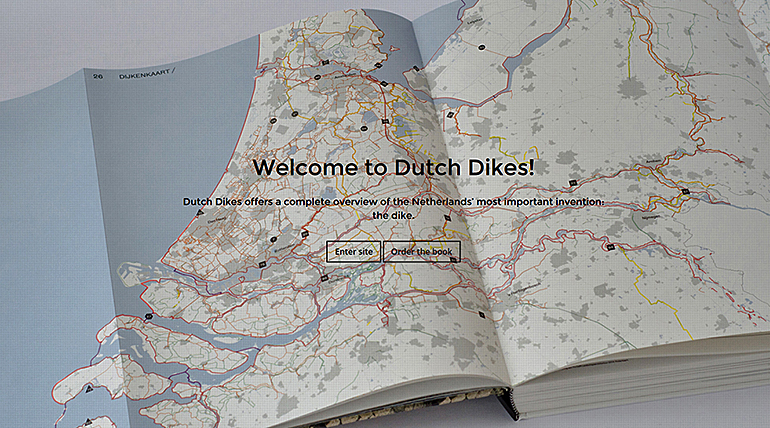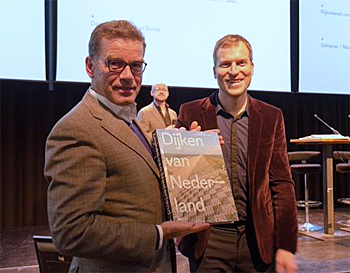Book launch: Dutch Dikes gives well documented overview of 22,500 km dikes
 The ultimate Dutch book with a remarkable presentation. The book Dutch Dikes was officially published in Amsterdam on 26 January. The well documented reference gives a complete overview of the Netherlands' most important invention: the dike.
The ultimate Dutch book with a remarkable presentation. The book Dutch Dikes was officially published in Amsterdam on 26 January. The well documented reference gives a complete overview of the Netherlands' most important invention: the dike.
The book proves to be a best-seller. It was already available for some weeks and at the official presentation the two authors Eric-Jan Pleijster and Cees van der Veeken of Lola Landscape architects had to announce that the first Dutch language edition of their book was already sold out.
Director Cees van 't Veen of the Dutch Cultural Heritage Agency (left on photo below) received one of the last three remaining copies from author Cees van der Veeken (right).
 One of the three last remaining copies of the first edition in Dutch for proud owner Cees van 't Veen.On the left is author Cees van der Veeken and in the back Eric-Jan Pleijster.
One of the three last remaining copies of the first edition in Dutch for proud owner Cees van 't Veen.On the left is author Cees van der Veeken and in the back Eric-Jan Pleijster.
Feat of civil engineering
The book - also available in English - gives an overview of the whole network of 22,500 km of dikes, dam and dike relics in the Netherlands.
What would this country be without these feats of engineering? One thing is certain: it would not exist in its current form. For more than 2,000 years, dikes have kept the land dry.
The dike-building acitivites picked up in the Early Middle Ages (700-800 A.D.) when the population started to grow and settlements needed flood protection.
Dikes are the framework of the Dutch landscape and hold an important role in daily life: the Dutch live in dike houses, spend weekends cycling along the winding dikes and visit the monument on the 32 km long Closure Dike.
 Ten 'best practises' are mentioned in the book, including the (hidden) dike-in-boulevard of The Hague/Scheveningen.
Ten 'best practises' are mentioned in the book, including the (hidden) dike-in-boulevard of The Hague/Scheveningen.
Many different types
Dutch Dikes presents an overview of the dikes in their current state, as well as offers a look towards the future. Based on the first map of dikes in the Netherlands, the dikes are characterised, explained and categorised in all their diversity. From drift dikes to summer dikes, from sea dikes to waterline dikes, and from dreamer dikes to guardian dikes: all forms of dikes are brought together in a unique, systematic genealogy.
In addition, the book features a surplus of dike anecdotes and in-depth portrayals of 40 of the 100 most remarkable Dutch dikes.
Special website
Much of the documented information in the book can also be found on the special website, including an interactive map of all dikes, an overview of the many different types and a review of 10 best practises.
On the website it is possible to order a copy, in print (49,50 euro) or e-book (39,50 euro).
More information
www.dutchdikes.net



